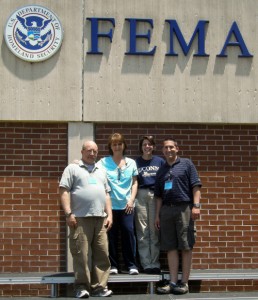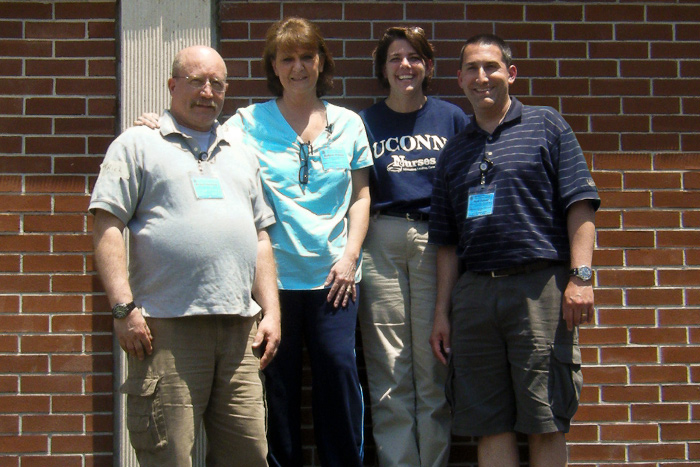
A group of UConn Health Center employees recently attended a week of disaster training at the Center for Domestic Preparedness (CDP) in Anniston, Ala.
Emergency department nurses Wendy Wheeler, Kathy Williams and Rich Hutchings, and environment of care safety officer Mark Petrone, attended the Healthcare Leadership and Administrative Decision Making for Mass Casualty Incidents course May 14-17.
“Most of us have done disaster training at our local hospital, but this training went above and beyond,” Wheeler says. “We were taught about local and federal response to disasters and how to integrate the two. Our training integrated with all levels of response from prehospital to emergency department, inpatient units and administrative, along with security.”
The health care leadership courses focus on teamwork among multiple jurisdictions that would respond to a mass casualty incident. They include both tabletop and simulated disaster response exercises. Both role players and highly functional simulation mannequins serve as disaster victims.
The courses take place at the former U.S. Army Noble Hospital in Anniston, which was converted to a training site for health and medical education in disasters and mass casualty events in 1999. The CDP is part of the Federal Emergency Management Agency.
“Nowhere would we be able to simulate the professional and realistic setting of the training that is as cost-effective, and the training facility is phenomenal,” Williams says. “Hospital staff is rarely afforded this education on this level.”
Hutchings, who’s been an ED nurse for more than 20 years and a firefighter and emergency medical technician for more than 35, says the CDP course was the most realistic training he’s experienced.
“The fact that this training took place in a real hospital and presented challenges that were well thought-out and enacted by well trained staff made you feel like this was the real deal and could easily happen,” Hutchings says. “The training brought to my attention a lot of ideas on how simple steps can prevent controlled chaos from becoming pure chaos.”
Petrone, who coordinates John Dempsey Hospital’s disaster drills and multiagency exercises involving the hospital and the Health Center, says an emergency management foundation is already in place here.
“So we are better prepared to respond, we have to provide more training to the staff who will be in the command and general staff roles of the Incident Command System,” he says. “Everyone needs to know what their roles and responsibilities are and they must be comfortable performing these roles under stressful conditions. One of the ways to accomplish this is through training and exercises.”
This was Petrone’s third CDP training course. He attended the “Incident Command System Train the Trainer” program in 2011, and “Pandemic Planning and Preparedness” in 2010.
Wheeler also had been to Anniston before for pandemic flu response training.
“This training helped me better understand not only my role as an emergency department nurse, but also how others in a hospital can and will need to function during a disaster,” Wheeler says.
Williams says many of the health care leadership training concepts could apply to any ED.
“The more staff trained, the more effective we become in the response not only to disasters but our daily needs and effectiveness in delivery of emergency care,” she says.
FEMA covers all travel and lodging and provides meals at no expense to the course attendees or the agencies sending them. Petrone says anyone who might benefit from CDP training should consider taking a course.
“Everyone who attends this type of training program will be better prepared to respond to a disaster,” Petrone says. “One of the greatest opportunities that come out of this type of training is that you are working with people from all over the country with various types of experiences. With this type of diverse environment, the students come home with more knowledge and they are better prepared to respond when the need arises.”
Another benefit, Hutchings says is sharing experiences with nurses from all over the country from emergency rooms of all sizes, and bringing back ideas for the Health Center’s ED and preparedness plans.
“I would encourage anyone involved in our preparedness process to attend this class,” Hutchings says. “Being away for a full week is difficult on work schedules and family, but the returns from what you will learn will make an impact on hundreds of lives one day.”
More information about CDP training programs is available at http://cdp.dhs.gov.
Editor’s note: Chris DeFrancesco, UConn Health Center communications officer and the writer of this story, also completed a CDP training course in Anniston, “Advanced Public Information Officer: Health and Hospital Emergencies,” May 21-24. This course focused on timely, accurate communications with the public and other stakeholders during emergency situations involving multiple agencies.
Follow the UConn Health Center on Facebook, Twitter and YouTube.



